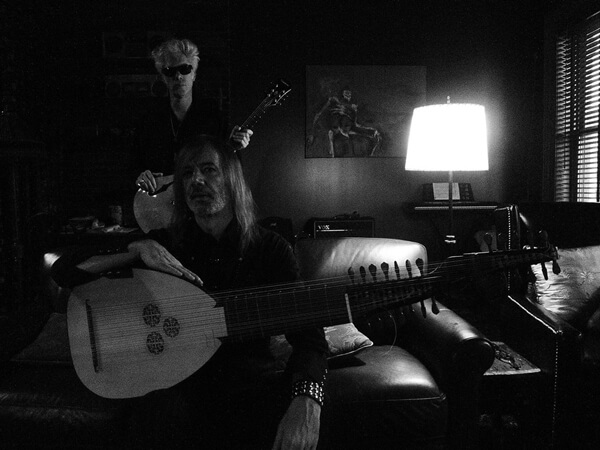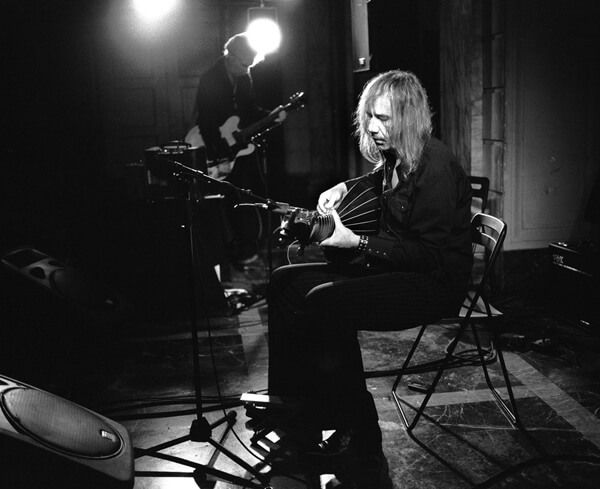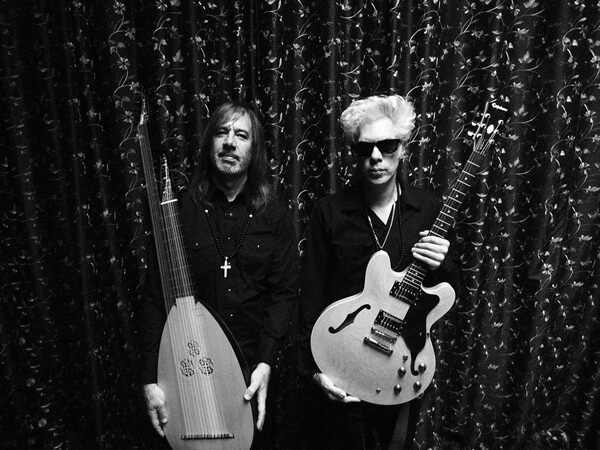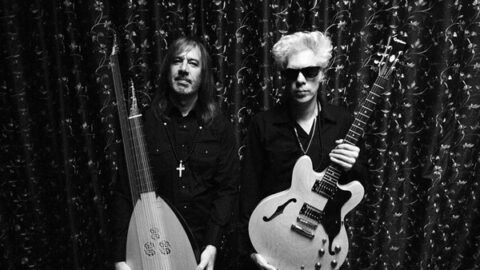 In a museum, 1,000 years from now, beside the wing of long extinct animals that contains the taxidermied visages of the African elephant and Rush Limbaugh, will stand the Hall of Ancient Musical Instruments. It’s there that one will find the harmonium, slide whistle, Keytar, and (fingers crossed) various auto-tuning devices. And perhaps, however difficult it is to imagine the music scene of the future bereft of guitars, that old instrument will be there too, sitting beside the lute, which in the year 3012 will still be old as hell. In our present musical universe, the lute is rarely taken out of its glass case and dusted off for performance in easy to find places. Enter Jozef van Wissem, a self-proclaimed champion of the lute in the 21st century, whose artistic bio reads like the mission statement of “Lute Liberation.” That mission landed at Le Poisson Rouge on Monday March 5, 2012, in the form of an unlikely partnership between van Wissem and indie director-cum-guitarist Jim Jarmusch.
In a museum, 1,000 years from now, beside the wing of long extinct animals that contains the taxidermied visages of the African elephant and Rush Limbaugh, will stand the Hall of Ancient Musical Instruments. It’s there that one will find the harmonium, slide whistle, Keytar, and (fingers crossed) various auto-tuning devices. And perhaps, however difficult it is to imagine the music scene of the future bereft of guitars, that old instrument will be there too, sitting beside the lute, which in the year 3012 will still be old as hell. In our present musical universe, the lute is rarely taken out of its glass case and dusted off for performance in easy to find places. Enter Jozef van Wissem, a self-proclaimed champion of the lute in the 21st century, whose artistic bio reads like the mission statement of “Lute Liberation.” That mission landed at Le Poisson Rouge on Monday March 5, 2012, in the form of an unlikely partnership between van Wissem and indie director-cum-guitarist Jim Jarmusch.

Apart from finally bringing the world an act to satisfy the oft ignored indie-movie-lute-enthusiast demographic, the bodies of work of both van Wissem and Jarmusch hint at the origins of their collaboration on the newly released record Concerning the Entrance into Eternity. While it is doubtful that Jarmusch is as passionate as van Wissem is when it comes to fighting for lute emancipation, the irreverence that is a staple of his films suggests that performing in a lute and guitar feedback duo is, for him, just another day at the office. His interest in music is well documented, singing in the Del Byzanteens in the 1980s and having cultivated relationships with musicians ranging from Tom Waits to The RZA that exemplify his eclecticism and fantastic taste. Moreover, as a director who films the majority of his pictures in monochrome, Jarmusch clearly has a soft spot for modes of artistic expression that have fallen by the wayside. His facility on the guitar was previously unknown to this reviewer, but is somehow unsurprising given his artistic versatility.
Van Wissem, on the other hand, has devoted his life to caddying his 13-course baroque lute from venue to venue in an effort to re-contextualize what so many people now consider an ancient novelty. He is a lutenist cut from a different cloth than the Paul O’Dettes and Nigel Norths of the world, purists whose relationships with the instrument dictate a commitment to classical authenticity. It’s safe to say van Wissem is not landing a gig with Ton Koopman any time soon, and thank heavens for that. From his unorthodox technique to his dazzlingly inventive original music, the impression is that within Mr. van Wissem is the spirit of a teenager from 1600 A.D. who secretly grabs a lute and flashes badass poses in his bedroom mirror, the walls no doubt lined with posters of Monteverdi, Dowland, and Sermisy, while his parents sit in the next room kvetching about his obsession with “those damn madrigals.”

For a Monday night, the crowd assembled at LPR was epic, and no doubt of the hundreds in attendance a high percentage was made up of stargazing fans of Jarmusch’s films. The first two pieces, performed by van Wissem alone, introduced the audience to the tonal palette and range of the lute. The nasal, raindrop-like color of the instrument was gorgeous, and showcased in a bustling, chattering, boozy milieu like that of LPR, immediately gave credence to van Wissem’s lute liberation campaign. The van Wissem originals, “The Great Joy” and “Concerning the Beautiful Human form After Death,” are contemporary pieces with ancient undertones, containing a finger-style bluegrassy feel with posterity nipping at its heels. Van Wissem’s distinctively un-baroque technique, dappled with plenty of untamed trills, vibratos, harmonics, and bends, quickly proved that the lute is not merely an anachronism but that, in the right hands, can be pointedly expressive and persuasive to modern ears.
Jarmusch joined van Wissem on stage and immediately set to make as much noise as possible. He proved to be adept at corralling feedback, dipping his guitar towards and away from his amplifier to produce thick, droning, guttural strains that at times sounded something like distorted maqamat. Wissem, for the most part, did not change his approach, playing familiar sounding motivic material from the first two pieces, yet the wail of Jarmusch’s guitar took those sounds and transformed them into one half of a dialogue, as if the voice of the lute represented a patient teacher, and the guitar’s that of some feral child. Towards the end of “Apokastastatis (Restoration),” scarce moments of sonority and imitation between the instruments sounded like success, and were astounding. Van Wissem did not contain himself to his seat, bobbing the lute in every which direction and challenging its dynamic limitations by bringing its sound-holes tenuously close to the microphone while playing in a low-slung, Jimmy Page-esque posture. There was a fantastic irony in the scene, a 600-year old instrument played collectedly in the hands of a performer writhing like Hendrix while the 20th century instrument belted out a continuous flow of primordial fuzz.

There is clearly a shared musical spirit between Jarmusch and van Wissem, yet both seemed entirely engrossed in their own playing, one rarely acknowledging the other. This absence of communication may have been less blatant if not for the one moment of pristine togetherness during the performance of the exasperatingly titled “He’s Hanging by His Shiny Arms, His Heart an Opened Wound with Love,” in which Jarmusch put down his electric guitar, picked up a steel-string acoustic one, and sat beside van Wissem. The tune they proceeded to play was intimate and beautiful, folky, traditional, and so joyous that as a listener it was hard not to whistle along. It was with this piece that van Wissem and Jarmusch found their greatest success as a performing duo and that the lute found its truest liberation, sounding out a highly enjoyable piece of music in an unconstrained 21st century setting before a crowd who, for most of the act, only heard its eloquence overshadowed by unkempt noise. Whether the lute belongs not just in sleepy concert halls but also in bustling venues featuring new music is a fascinating question. Van Wissem’s riposte is to thrust it into such locales, and for this performance, brazenly risked making it seem even more curmudgeonly and arthritic by putting it face to face with its newer, thinner, sexier, great-great-great grandson, the electric guitar. And perhaps it’s all right that the lute needed the young upstart to settle down and cooperate a tad to truly shine – after all, haven’t we all been taught to respect our elders?
























